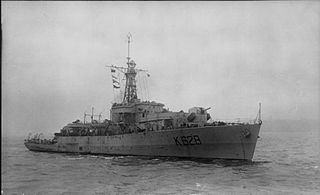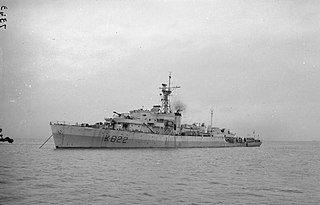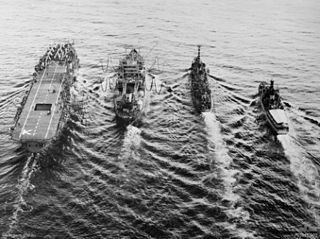
HMS Loch Fada was the lead ship of the Loch-class frigates of the British Royal Navy, built by John Brown & Company of Clydebank, Scotland, and named after Loch Fada in the Inner Hebrides.

HMS Loch Insh was a Loch-class frigate of the Royal Navy, named after Loch Insh in Scotland. She was built by Henry Robb of Leith and launched on 10 May 1944. After service at the end of World War II she was decommissioned, but reactivated in 1950 and served, mostly in the Persian Gulf, until 1962. The ship was sold to the Royal Malaysian Navy in 1963 and renamed KD Hang Tuah (F433). She was scrapped in 1977.

HMS Loch Killisport (K628/F628) was a Loch-class frigate of the British Royal Navy, named after Loch Killisport in Scotland. Launched in 1944, the ship was not commissioned until July 1945, and served in post-war repatriation operations in the Far East until decommissioned in April 1946. During this time Prince Philip was an officer on board this ship. Recommissioned in 1950 she served in the Home Fleet for two years, before being extensively modernised for service in the Persian Gulf and Far East. Decommissioned in August 1965, she was sold for scrapping in 1970.

HMS Loch Lomond was a Loch-class frigate of the British Royal Navy. The ship was named after Loch Lomond in Scotland.

HMS Morecambe Bay was a Bay-class anti-aircraft frigate of the British Royal Navy, named after Morecambe Bay on the north western coast of England. In commission from 1949 until 1956, she saw active service in the Korean War, and was sold to Portugal in 1961 to serve as NRP Dom Francisco de Almeida until 1970.

HMS Mounts Bay was a Bay-class anti-aircraft frigate of the British Royal Navy, named after Mount's Bay in Cornwall. In commission from 1949 until 1960, she saw active service in the Korean War, and was sold to Portugal in 1961 to serve as NRP Vasco da Gama until 1971.
HMS Porlock Bay was a Bay-class anti-aircraft frigate of the British Royal Navy, named for Porlock Bay on the northern coast of Somerset. Commissioned in 1946, she served on the American and West Indies Station and as a Fisheries Protection Vessel before being put into reserve in 1949. She was sold to Finland in 1962 and served as the training ship Matti Kurki until 1974.

HMS Burghead Bay was a Bay-class anti-aircraft frigate of the British Royal Navy, named for Burghead Bay in Morayshire.

HMS Cardigan Bay was a Bay-class anti-aircraft frigate of the British Royal Navy, named after Cardigan Bay, off the coast of Ceredigion, Wales.
HMS Padstow Bay was a Bay-class anti-aircraft frigate of the British Royal Navy, named for Padstow Bay on the northern coast of Cornwall. Commissioned in 1946, she served on the American and West Indies Station only until 1947 before being put into reserve, and then sold for scrapping in 1959.
HMS St Austell Bay was a Bay-class anti-aircraft frigate of the British Royal Navy, named after St Austell Bay on the south coast of Cornwall. In commission from 1945 until 1956, she served in the Mediterranean Fleet and on the America and West Indies Squadron.
HMS St Brides Bay was a Bay-class anti-aircraft frigate of the British Royal Navy, named for St Brides Bay in Pembrokeshire. In commission from 1945 to 1961, she served in the Mediterranean and Eastern Fleets, seeing active service in the Korean War.
HMS Start Bay (K604/F604) was a Bay-class anti-aircraft frigate of the British Royal Navy, named for Start Bay in Devon. In commission from 1945 to 1946 in the Mediterranean Fleet, she spent most of her career in the Reserve Fleet.

HMS Veryan Bay was a Bay-class anti-aircraft frigate of the British Royal Navy, named after Veryan Bay on the south coast of Cornwall. In commission from 1945 until 1957, she saw service in the Pacific, Mediterranean, and Home Fleets, in the West Indies and in the South Atlantic.

HMS Whitesand Bay was a Bay-class anti-aircraft frigate of the British Royal Navy, named for Whitesand Bay in Cornwall. In commission from 1945 to 1954, she served in the Pacific, Mediterranean, West Indies and Far East Fleets, seeing active service in the Korean War.

HMS Alert a Bay-class frigate of the Royal Navy. She was originally laid down as the Loch-class vessel Loch Scamdale, and re-ordered as Dundrum Bay while building. She was completed as Alert, an Admiralty Yacht for command and gunboat diplomacy duties in the Mediterranean and Far Eastern stations.

HMS Loch Fyne was a Loch-class frigate of the British Royal Navy, built by the Burntisland Shipbuilding Company Ltd, Burntisland, Fife, Scotland, and named after Loch Fyne in Scotland. The ship was launched in 1944, and served at the end of World War II. Recommissioned in 1951, she served in the Persian Gulf and was scrapped in 1970.

HMNZS Rotoiti (F625) was a Loch-class frigate of the Royal New Zealand Navy (RNZN), which had formerly served in the British Royal Navy as HMS Loch Katrine at the end of World War II.

HMNZS Hawea (F422), formerly HMS Loch Eck (K422), was one of six Loch-class frigates that served in both the Royal Navy (RN) and the Royal New Zealand Navy (RNZN). The ship was laid down by Smiths Dock on 25 October 1943, launched on 25 April 1944 and commissioned into the Royal Navy as HMS Loch Eck on 7 November 1944.

HMS Loch Achray was a Loch-class frigate of the Royal Navy. She was built by Smith's Dock Co. Ltd. in South Bank-on-Tees and launched on 7 July 1944. After service in World War II, she was sold to the Royal New Zealand Navy and renamed HMNZS Kaniere (F426) in September 1948. After service in the Korean War, she was used as a training ship from 1957. She was sold in 1966 for breaking up in Hong Kong.















